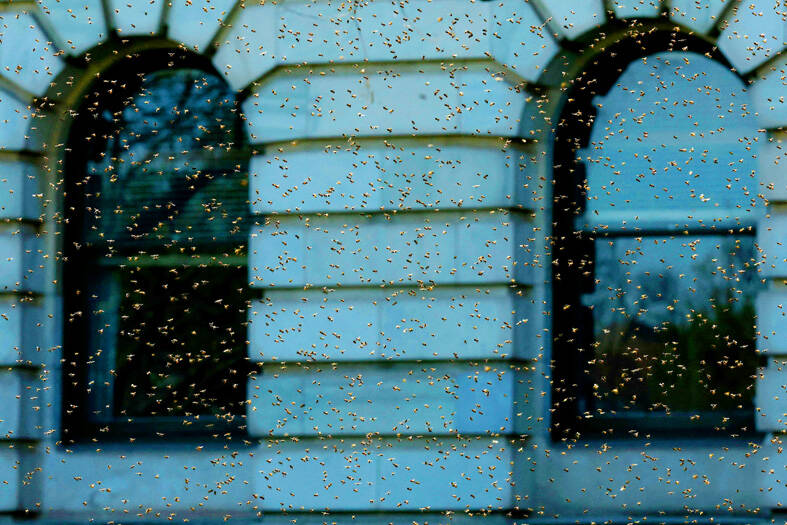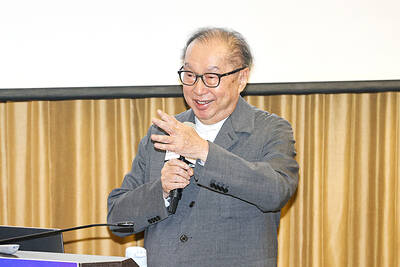Dutch scientists have unveiled the country’s first laboratory to research how autonomous miniature drones can mimic insects to accomplish tasks ranging from finding gas leaks in factories to search-and-rescue missions.
Called the Swarming Lab, researchers at the Delft University of Technology (TU Delft) say they aim to put a “self-flying” swarm of 100 tiny drones in the air, able to perform around the clock tasks.
This included the drones landing by themselves on recharging pods and taking off again to continue flying — without humans ever having to get involved.

Photo: AFP
“We are working not only to get these robots to be aware of one another, but also work together to complete complex tasks,” Swarming Lab director Guido de Croon said.
Tasks include the tiny drones — with the same weight as a golf ball or an egg — “sniffing out” a gas leak in a factory.
A swarm of autonomous drones, fitted with sensors to detect the gas, would be able to fly autonomously around the factory until one drone detects traces of the gas.
It will then follow the “scent” of the gas while “calling” the other drones to help in the search using on-board sensors.
“In the same way, drone swarms can also be used to detect forest fires or continuously help in search and rescue operations over large areas,” De Croon said.
The scientists use studies on bee and ant swarms or how flocks of birds behave to try and program their drone swarms to do the same.
“Drone swarm technology is the idea that when we look at nature and you see many of these animals like ants, that individually are perhaps not so smart, but together they do... things that they could definitely not do by themselves,” De Croon said.
“We want to instill the same capabilities also in robots,” he said.
Doing this, the scientists look at how birds or insects swarm “using very simple behaviors,” he said.
For example, birds “look at their closest neighbors in the flock and they do things like: ‘Oh, I don’t want to be too close’ because they don’t want to collide,” De Croon said. However, “‘I also don’t want to be the only one to be away from the flock.’”
“They align with each other, and by following such simple rules you get these beautiful patterns that are very useful for the birds, also against predators,” he said. “So at that level, we draw inspiration and we try to make such simple rules also for robots but then for the applications we want to tackle.”
The scientists admit there are some challenges.
“Swarms are complex systems,” De Croon said at a demonstration of the technology at the Swarming Lab, inside TU Delft’s Science Centre. “A single robot can do simple things within a swarm.”
“It is actually quite difficult to predict, however, with these simple rules how a whole swarm will behave,” he said.
The small size of the robots also hampers the amount of technology like sensors and onboard computing capacity the tiny drones can carry.
The drones at the Swarming Lab still rely on an externally mounted camera to relay information to the buzzing beasts on their positions within the swarm.
However, the researchers have already developed the technology for robots to sense each other without external help.
They would not be the first: Scientists from Zhejiang University in China in 2022 flew 10 autonomous drones through a thick bamboo forest.
The Swarming Lab, working together with a start-up company of former TU Delft students called Emergent Swarm Solutions, has about 40 small drones involved in its research.
“The aim is eventually to put a swarm of around 100 drones in the air in the next five years,” Emergent cofounder Lennart Bult said.
Ultimately “it would be really great if we actually get a bit closer to the astonishing intelligence of tiny creatures like honeybees,” De Croon said.

BYPASSING CHINA TARIFFS: In the first five months of this year, Foxconn sent US$4.4bn of iPhones to the US from India, compared with US$3.7bn in the whole of last year Nearly all the iPhones exported by Foxconn Technology Group (富士康科技集團) from India went to the US between March and last month, customs data showed, far above last year’s average of 50 percent and a clear sign of Apple Inc’s efforts to bypass high US tariffs imposed on China. The numbers, being reported by Reuters for the first time, show that Apple has realigned its India exports to almost exclusively serve the US market, when previously the devices were more widely distributed to nations including the Netherlands and the Czech Republic. During March to last month, Foxconn, known as Hon Hai Precision Industry

Taiwan Semiconductor Manufacturing Co (TSMC, 台積電) and the University of Tokyo (UTokyo) yesterday announced the launch of the TSMC-UTokyo Lab to promote advanced semiconductor research, education and talent development. The lab is TSMC’s first laboratory collaboration with a university outside Taiwan, the company said in a statement. The lab would leverage “the extensive knowledge, experience, and creativity” of both institutions, the company said. It is located in the Asano Section of UTokyo’s Hongo, Tokyo, campus and would be managed by UTokyo faculty, guided by directors from UTokyo and TSMC, the company said. TSMC began working with UTokyo in 2019, resulting in 21 research projects,

Ashton Hall’s morning routine involves dunking his head in iced Saratoga Spring Water. For the company that sells the bottled water — Hall’s brand of choice for drinking, brushing his teeth and submerging himself — that is fantastic news. “We’re so thankful to this incredible fitness influencer called Ashton Hall,” Saratoga owner Primo Brands Corp’s CEO Robbert Rietbroek said on an earnings call after Hall’s morning routine video went viral. “He really helped put our brand on the map.” Primo Brands, which was not affiliated with Hall when he made his video, is among the increasing number of companies benefiting from influencer

Quanta Computer Inc (廣達) chairman Barry Lam (林百里) yesterday expressed a downbeat view about the prospects of humanoid robots, given high manufacturing costs and a lack of target customers. Despite rising demand and high expectations for humanoid robots, high research-and-development costs and uncertain profitability remain major concerns, Lam told reporters following the company’s annual shareholders’ meeting in Taoyuan. “Since it seems a bit unworthy to use such high-cost robots to do household chores, I believe robots designed for specific purposes would be more valuable and present a better business opportunity,” Lam said Instead of investing in humanoid robots, Quanta has opted to invest